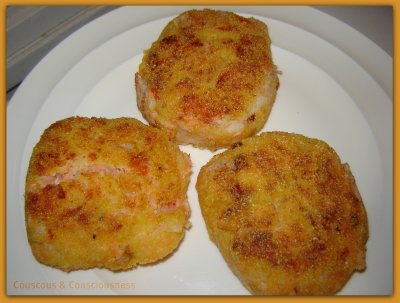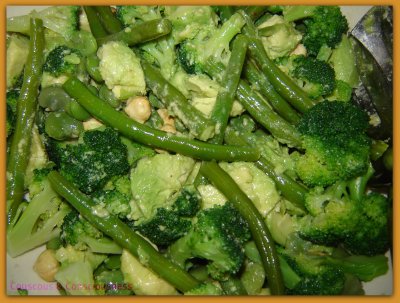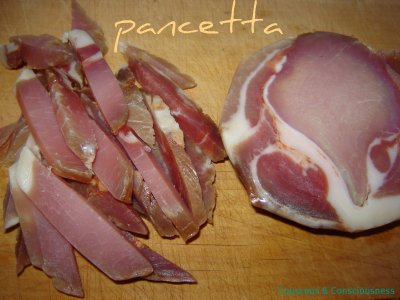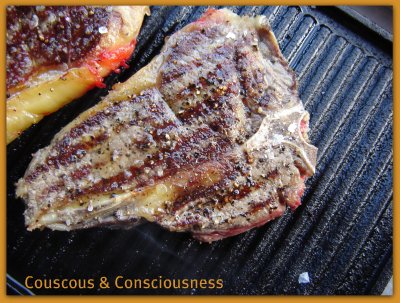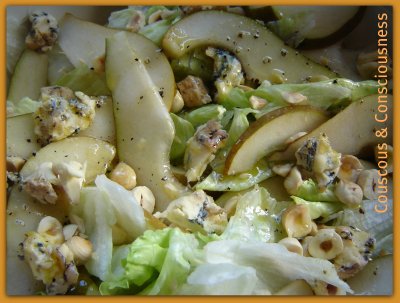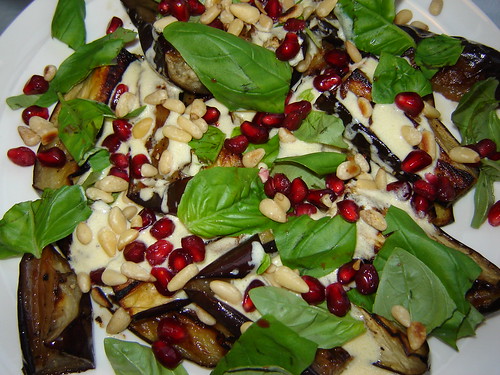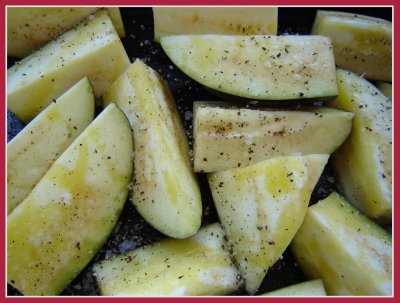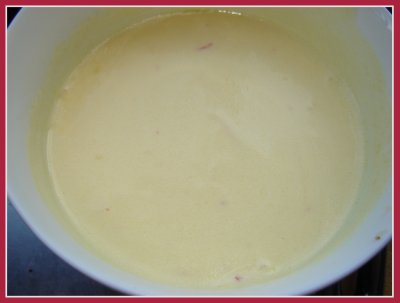"What would you like for your birthday?" my partner asked me a couple of months ago. After a little bit of thought, "a kitchen blackboard" was my reply. As I have always dreamed of having a kitchen blackboard, and since making blackboards is one of the many things that my partner does, I don't know why it had never occurred to me to ask for one before. In actual fact the blackboard of my dreams is about 3 metres long and takes up one whole wall of my kitchen - but then I would also need the kitchen of my dreams to fit it into. Our present kitchen is tiny, and just about every square inch of space is maximised, but "I would like one to fit there", I said, pointing to the last vestige of empty wall space behind the door and beside the fridge. So I was overjoyed when my birthday came around and this is what I got ...
It fits perfectly in the space, and now I use it so much I don't know how I ever got by without it. Because I teach in the evenings, I have to be quite organised with meals - planning things that can be partly prepared during the day in between classes, and then quickly completed after I finish classes in the evening. The board has turned out to be absolutely indispensable in my planning process, which goes something like this ...
I usually think of Friday as one of my leisure kind of days - no classes until the evening and all the chores done earlier in the week. So Friday is the day I like to get several cookbooks down off the shelves and think about a "draft" menu plan for the week ahead - in that planning I think about what is likely to be seasonally available and also what commitments (classes, private lessons, other appointments, etc) I have during the week, and what I can fit in and prep around those commitments. Saturday mornings I then head off to the market to pick up my vegetables, and then Saturday afternoon the menu plan gets a bit of a "tweek" depending on what I was able to get at the market. Sometimes the plan gets a major transformation if I've come home with some totally unexpected finds at the market, or couldn't get a lot of what I had in mind.
So then the menu plan goes up on the board, and then .... I know this is going to sound really scary to some of you .... using a very clever little application that I have on my iPhone called "Mise en Place", I schedule in what I can prepare ahead and when. I know that might seem almost nauseatingly well organised (and those who know me will be surprised by this, because being organised is not really my strong suit - my motto has always been "why do today what you can put off till tomorrow?"), but for me there is nothing worse than getting home at 8pm with no idea what's for dinner. I pretty much never have anything in the way of ready-made food in the house - if you want something to eat in my house, you have to make it. And I'm afraid I'm not one of those cooks who can dive into the fridge, come out with several ingredients, and half an hour later something stunning and delicious is on the table - oh, how I envy those people. I, on the other hand, need to have a plan. I wouldn't survive the first round on Master Chef!
As the week goes along, and I run out of anything in the pantry, I jot that up on the board so that then goes on the shopping list for the next week. Also if I find things in the cupboard or fridge that need to get used up - for example some yoghurt to be used up, or dressing or sauce leftover from something I made earlier in the week - then I also note that on the board, so then when I'm planning the next week's menu I think of things that could use those leftovers. Or maybe someone will bring me some goodies from their garden, so then those treats will be the springboard for the forthcoming plan.
So it was last week - a very kind student brought me the biggest, most beautiful bunch of mixed fresh herbs from her garden. In the bunch there was rosemary, bay, Vietnamese mint, dill, tarragon, and sage, so I had great fun planning this week's menu to make the most of these gorgeous herbs, and I thought I would share with you what's coming out of my kitchen this week:
Saturday night I made an adaptation of this Fried Fish with Noodles & Asian Herbs recipe by Ray McVinnie. I used fresh chillies in my dressing instead of dried, and in the absence of limes I used lemon juice. I also substituted monkfish for the John Dory. I used a mixture of basil, dill, mint and Vietnamese mint leaves, and lime-pepper macadamia nuts instead of peanuts.
Last night I made Pork Schnitzels, from Falling Cloudberries by Tessa Kiros . The schnitzels are marinated for a while in a mix of egg yolks, garlic, chopped rosemary and garlic, before crumbing and frying. I made a lemon tarragon mayonnaise to go with them (which incidentally was so good, it has now become my favourite new thing), along with some crunchy potatoes roasted with rosemary and bay leaves. The meat lover in the house declared these to be delicious, and told me that I could make them again!
. The schnitzels are marinated for a while in a mix of egg yolks, garlic, chopped rosemary and garlic, before crumbing and frying. I made a lemon tarragon mayonnaise to go with them (which incidentally was so good, it has now become my favourite new thing), along with some crunchy potatoes roasted with rosemary and bay leaves. The meat lover in the house declared these to be delicious, and told me that I could make them again!
Yesterday afternoon I also made Spinach Gnocchi (preparation for dinner tonight, as well as some to go in the freezer for another night) from Essentials of Classic Italian Cooking by Marcella Hazan . This is also a Cooking Italy assignment, and we are supposed to serve it with a tomato cream sauce, but I'm going to use up some of that sage in a Sage Butter Sauce.
. This is also a Cooking Italy assignment, and we are supposed to serve it with a tomato cream sauce, but I'm going to use up some of that sage in a Sage Butter Sauce.
Tuesday night will be one of my regular favourites - pasta with aubergine, currants, capers and pine nuts from Epicurious. I love this - the sauce can easily be made in advance, in fact I usually make a big batch and then freeze it in portions big enough for just me. Then on a night when I need to appease my meat lover with a piece of ... well, meat ... I can boil some pasta and reheat some of this sauce for myself in less time than it takes to say "pork chop", well almost! Mmmm, just thinking that some of those beautiful Purple Cherokee tomatoes I got at the market on Saturday could also find their way into this batch of the sauce.
Wednesday I'm making Soy Chicken from the new Donna Hay book - "Seasons". This involves marinating the chicken in advance and then partly cooking the chicken by poaching in the marinade, which I can do earlier in the day. The final part of the cooking process is 20 minutes in a hot oven to finish cooking and crisp up the skin, which can easily be done after work, and during which time I can cook some rice and steam some green vegetables.
Thursday I'm planning Grilled Mackerel with green olive, celery and raisin salsa from Ottolenghi, The Cookbook. I have been itching to try this recipe ever since I got this book, and as we have two huge bunches of celery to use up (long story), this seems like the perfect time to put this one on the menu.
Friday is going to be Hot-Smoked Salmon Cakes with Green Salad. I always have a few packets of hot-smoked salmon from Holy Smoke in the fridge, so these are a great stand-by. They have been a favourite since I saw Julie Biuso make them at the Savour New Zealand Master Class back in 2001. I've adapted the recipe a little - leaving out the onion, and coating the formed cakes in polenta before frying - but the real secret to these delicately light fishcakes is in the way that Julie recommends treating the potatoes. These would also be beautiful eaten cold the next day if you had any leftovers, but I can pretty much guarantee there won't be any.
Hot-Smoked Salmon Cakes Recipe
Adapted from a recipe by Julie Biuso
Makes 6
Click here for a printable copy of this recipe
300-350g hot-smoked salmon
350g waxy potatoes, whole, skins on
1 egg
salt & pepper
polenta
olive oil for frying
Flake the salmon into pieces.
Keep the potatoes whole, and leave the skins on. Boil in well salted water until just barely fork tender. Now this is what makes these light as air, so don't try to take any shortcuts here - drain the potatoes and leave until completely cold, even better if you can put them in the fridge for a couple of hours. Then peel the skins off (they will come off very easily), and grate the potatoes using the cheese shredding side of a box grater. If you try to do this while the potatoes are still warm they go all "gluey" and horrible, instead of light and fluffy.
In a bowl mix the flaked salmon, grated potato, the egg, salt and pepper together well. Shape into "cakes", coat lightly all over with polenta, place on a plate lined with non-stick baking paper, and set aside until ready to cook. They are very soft and tender, so I find that chilling them for a couple of hours at this stage makes them easier to handle.
Heat a pan with a bit of olive oil and fry the cakes until browned all over - remember that you are not really trying to cook anything, but you want them to warm through to the centre (which will be enough to cook the little bit of egg), and to be golden and crispy on the outside.
I like to serve these with a green salad - the thing about green salad, is that it can contain any combination of ingredients that you like, but they must be green. The only exception is perhaps some croutons or nuts or cheese - which I think of as being colour "neutral", but no red, yellow, orange, purple - you get the picture - no tomato, peppers, carrots, corn, etc. There is a time for all that, but this is not it. Try to restrain yourself. Just greens and a lemony vinaigrette. You can see that in this one I used broccoli, green beans, broad beans, avocado and hazelnuts, but just use your imagination and whatever is in season.



